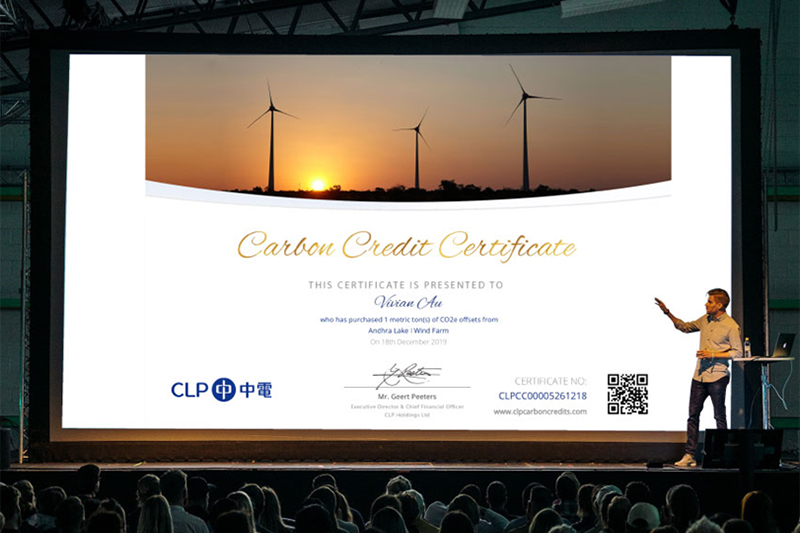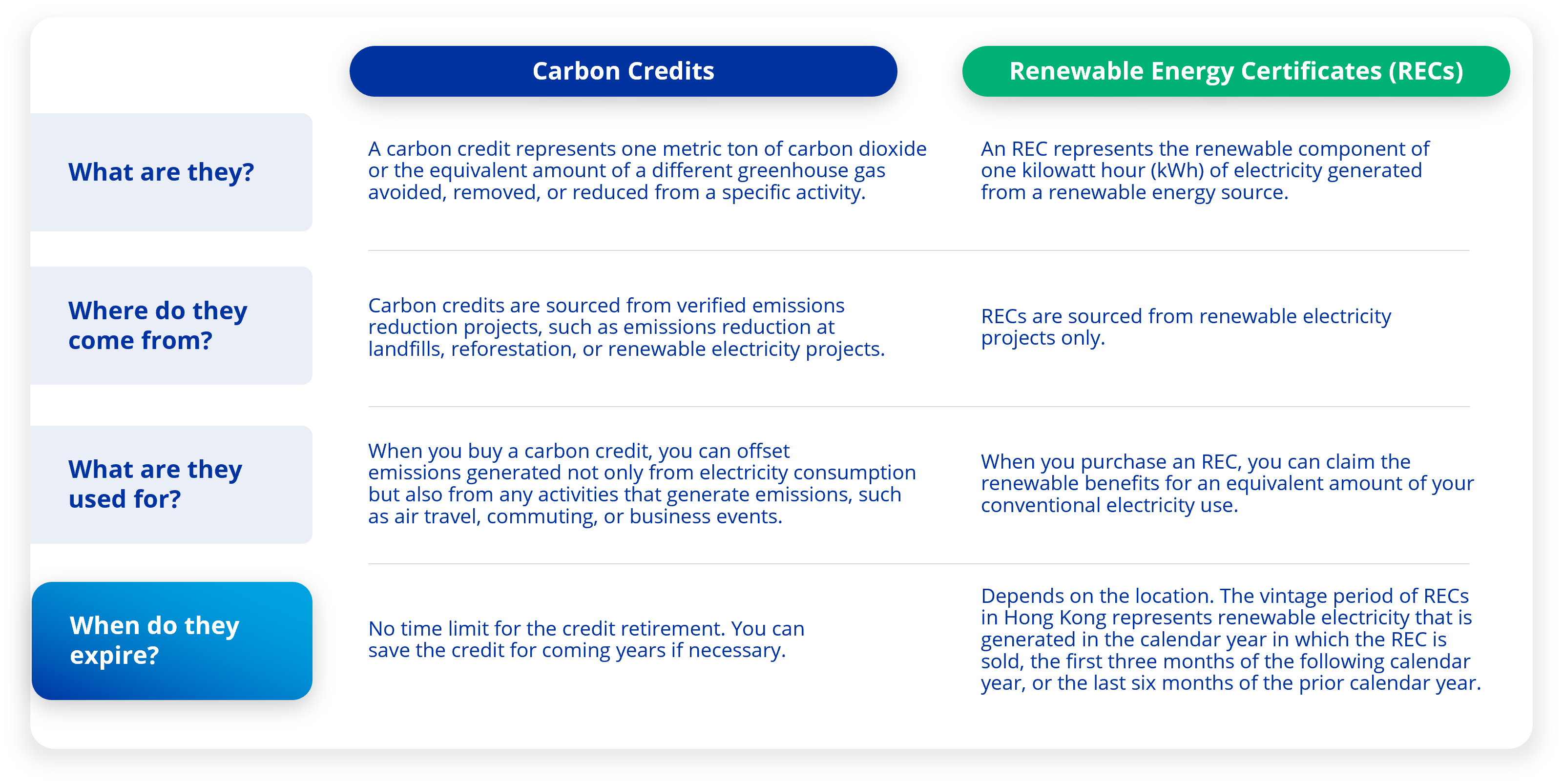FAQ
Discover the answers to commonly asked questions about Carbon Credits here.
FAQ
Discover the answers to commonly asked questions about Carbon Credits here.
Carbon credits allow organisations or companies to offset their GHG emissions by supporting renewable energy projects that reduce or remove carbon emissions.
Different climate commitment frameworks may have different requirements on GHG accounting or acceptance of carbon offsets. Customers are advised to check with the relevant governance bodies or contact us to know more.
Certified Emission Reduction (CER)
Certified Emission Reduction (CER) refers to credits issued under the Clean Development Mechanism (CDM) and represents a reduction of one metric tonne of CO2e. The CDM was created by the Kyoto Protocol. It allows an industralised country with an emission-reduction or emission-limitation commitment under the Protocol to implement emission-reduction projects in a developing country. CDM provides a process for registering projects in developing countries and issuing credits from those projects. CERs were purchased by entities under the European Union’s Emissions Trading Scheme (ETS) to offset emissions. Click here to visit the CDM Registry.
Since these credits are also generated through an internationally recognised process, they are also sold in the voluntary carbon market because buyers trust their legitimacy.
CLP has a significant number of legacy CERs in Mainland China and India.
Verified Emission Reduction (VER)
Verified Emission Reduction (VER) refers to credits issued by the Verified Carbon Standard (VCS) and represents a reduction of one metric tonne of CO2e. The VCS is a robust, global standard for the approval of credible voluntary carbon credits. VCS is currently the most widely known and chosen voluntary standard. In order for a project to qualify for VCS, several criteria must be met. Abatement must have occurred, and it should go beyond business-as-usual activities. It should be measurable and permanent. Furthermore, the findings of the project must be independently verified. VCS is also compatible with the CDM. Click here to visit the VCS registry.
Step 1: Confirm the order information
Information to be provided should include customer contact, company information and total number of carbon credits to purchase.
Step 2: Sign the CLP Carbon Credits Sale Agreement
The agreement will be between you or your organisation and the specific CLP Carbon Credits project.
Step 3: Invoice will be issued once the Sale Agreement is signed
Step 4: Bank transfer to bank account in Mainland China and India
The payment must be settled by bank transfer, cheque is not accepted. Kindly note that all bank charges would have to be borne by the buyer (i.e. bank charges will be made to buyers’ recipient bank account or debit account).
Step 5: Issuance of Carbon Credit Certificate
Once the payment is duly received by CLP China or Apraava Energy, the Carbon Credit Certificates will then be issued.
CLP only accepts an offline transaction where payment can be made via wire transfer. For more information, please feel free to contact us at clpcarboncredits@clp.com.hk. Please note that we will do our best to respond to you within 5 working days.

If you buy a Carbon Credit from CLP you will receive:
- a CLP Carbon Credit Certificate attached to the email which identifies the customer as the purchaser of the specified number of credits; and
- a credit retiring certificate from registry (CDM/VCS) (optional)
- an email confirming receipt of payment.
One CLP Carbon Credit represents one metric tonne of CO2e. CO2e, or carbon dioxide equivalent, is a standard unit for measuring carbon footprint.
There are several different categories of greenhouse gases (GHG). Six GHGs (among which include CO2) are controlled by the Kyoto Protocol and each of them have a different ability to heat the atmosphere. Each GHG’s ability to heat the atmosphere has been formally defined as a multiple of CO2’s ability to heat the atmosphere. This number is referred to as the “Global Warming Potential” (GWP) (e.g. CO2 has a GWP of 1). For simplicity, when calculating GHG emissions, all six GHGs are combined based on their GWP and reported as though they were equivalent to a given volume of CO2. The resulting number is called CO2e.
The CLP Carbon Credit Certificate you receive will be in the same language as the one used on the website.
When accessing the English website, the certificate and the name on the certificate will be in English.
On the Chinese website, the certificate will be in Chinese. However, the name on the certificate can be in either Chinese or English.

Carbon credits allow organisations or companies to offset their GHG emissions by supporting renewable energy projects that reduce or remove carbon emissions.
Different climate commitment frameworks may have different requirements on GHG accounting or acceptance of carbon offsets. Customers are advised to check with the relevant governance bodies or contact us to know more.
Certified Emission Reduction (CER)
Certified Emission Reduction (CER) refers to credits issued under the Clean Development Mechanism (CDM) and represents a reduction of one metric tonne of CO2e. The CDM was created by the Kyoto Protocol. It allows an industralised country with an emission-reduction or emission-limitation commitment under the Protocol to implement emission-reduction projects in a developing country. CDM provides a process for registering projects in developing countries and issuing credits from those projects. CERs were purchased by entities under the European Union’s Emissions Trading Scheme (ETS) to offset emissions. Click here to visit the CDM Registry.
Since these credits are also generated through an internationally recognised process, they are also sold in the voluntary carbon market because buyers trust their legitimacy.
CLP has a significant number of legacy CERs in Mainland China and India.
Verified Emission Reduction (VER)
Verified Emission Reduction (VER) refers to credits issued by the Verified Carbon Standard (VCS) and represents a reduction of one metric tonne of CO2e. The VCS is a robust, global standard for the approval of credible voluntary carbon credits. VCS is currently the most widely known and chosen voluntary standard. In order for a project to qualify for VCS, several criteria must be met. Abatement must have occurred, and it should go beyond business-as-usual activities. It should be measurable and permanent. Furthermore, the findings of the project must be independently verified. VCS is also compatible with the CDM. Click here to visit the VCS registry.
Step 1: Confirm the order information
Information to be provided should include customer contact, company information and total number of carbon credits to purchase.
Step 2: Sign the CLP Carbon Credits Sale Agreement
The agreement will be between you or your organisation and the specific CLP Carbon Credits project.
Step 3: Invoice will be issued once the Sale Agreement is signed
Step 4: Bank transfer to bank account in Mainland China and India
The payment must be settled by bank transfer, cheque is not accepted. Kindly note that all bank charges would have to be borne by the buyer (i.e. bank charges will be made to buyers’ recipient bank account or debit account).
Step 5: Issuance of Carbon Credit Certificate
Once the payment is duly received by CLP China or Apraava Energy, the Carbon Credit Certificates will then be issued.
CLP only accepts an offline transaction where payment can be made via wire transfer. For more information, please feel free to contact us at clpcarboncredits@clp.com.hk. Please note that we will do our best to respond to you within 5 working days.

If you buy a Carbon Credit from CLP you will receive:
- a CLP Carbon Credit Certificate attached to the email which identifies the customer as the purchaser of the specified number of credits; and
- a credit retiring certificate from registry (CDM/VCS) (optional)
- an email confirming receipt of payment.
One CLP Carbon Credit represents one metric tonne of CO2e. CO2e, or carbon dioxide equivalent, is a standard unit for measuring carbon footprint.
There are several different categories of greenhouse gases (GHG). Six GHGs (among which include CO2) are controlled by the Kyoto Protocol and each of them have a different ability to heat the atmosphere. Each GHG’s ability to heat the atmosphere has been formally defined as a multiple of CO2’s ability to heat the atmosphere. This number is referred to as the “Global Warming Potential” (GWP) (e.g. CO2 has a GWP of 1). For simplicity, when calculating GHG emissions, all six GHGs are combined based on their GWP and reported as though they were equivalent to a given volume of CO2. The resulting number is called CO2e.
The CLP Carbon Credit Certificate you receive will be in the same language as the one used on the website.
When accessing the English website, the certificate and the name on the certificate will be in English.
On the Chinese website, the certificate will be in Chinese. However, the name on the certificate can be in either Chinese or English.

